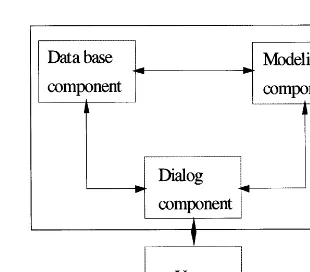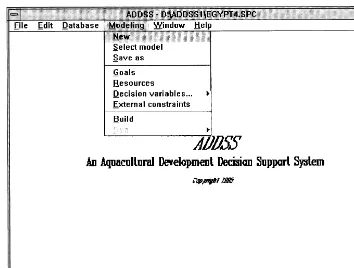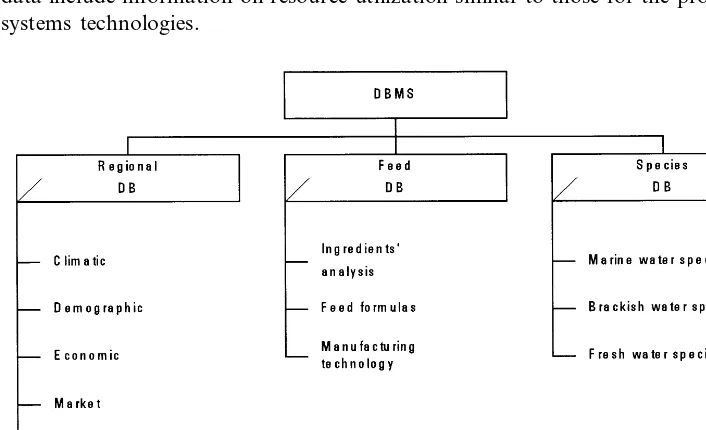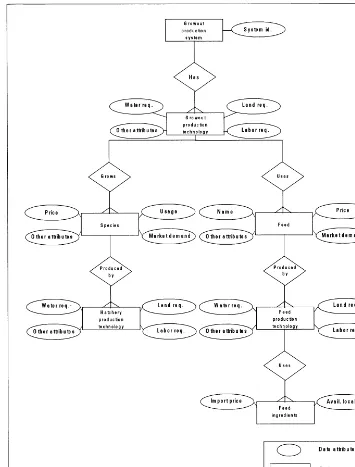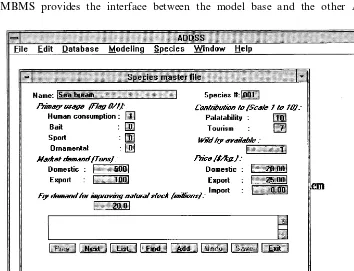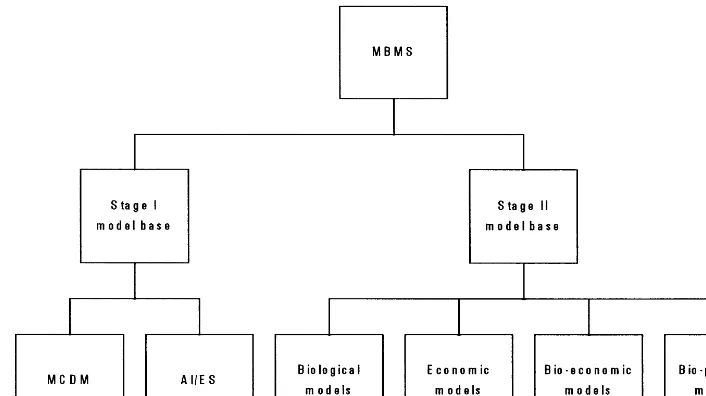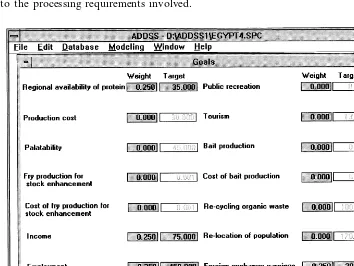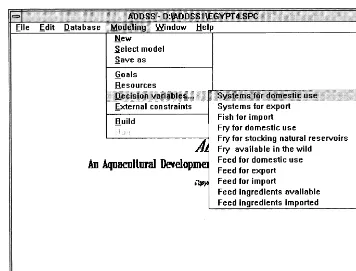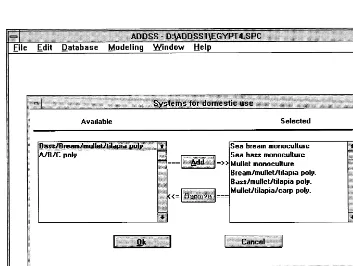ADDSS: a tool for regional aquaculture
development
Omar F. El-Gayar
a,*, PingSun Leung
baDepartment of Information Technology,Institute of Graduate Studies and Research, Uni6ersity of Alexandria,163 El-Horreya A6e.,El-Shatby,Alexandria, Egypt bDepartment of Biosystems Engineering,Uni
6ersity of Hawaii at Manoa,3050 Maile Way, Gilmore 111,Honolulu,HI 96822, USA
Received 10 June 1998; accepted 14 July 1999
Abstract
Aquaculture is considered as a viable source for providing high quality and cheap protein, particularly for developing countries with protein shortages. However, due to its complexi-ties, aquaculture development planning can be difficult without the aid of modern decision-making technologies such as decision support systems (DSS). DSS are widely used in the business and manufacturing sectors, but their use in agriculture is limited and in aquaculture is almost nonexistent. This paper presents the design and implementation of an aquacultural development decision support system (ADDSS) that would systematically aid the planner in making choices regarding the development planning of the aquaculture industry for a given region. The system is composed of three main components: a model base containing all relevant models which are essentially multiple objective in nature, a database containing all relevant data, and a dialog component providing a user interface to the other two components of the system. The application of ADDSS is demonstrated through a case study from Northern Egypt where aquaculture appears as a viable industry for supplying cheap and good quality protein, balancing the foreign exchange deficits, improving the standard of living, and creating employment opportunities. © 2000 Elsevier Science B.V. All rights reserved.
Keywords:Decision support systems; Multiple criteria decision-making; Aquaculture
www.elsevier.nl/locate/aqua-online
* Corresponding author.
E-mail addresses:[email protected] (O.F. El-Gayar), [email protected] (P. Leung)
182 O.F.El-Gayar,P.Leung/Aquacultural Engineering23 (2000) 181 – 202
1. Introduction
1.1.General background
Personal computers, computer networks, large databases, color graphics and computer-based models are among the technological developments which stimulate interest in the use of computers to support decision-making. Such uses are called ‘decision support systems’ (DSS). Decision support systems are used as aids to enhance the effectiveness of the decision-making process in organizations. Cur-rently, many organizations operating in various business domains utilize DSS. Aquaculture is one of the fields that are looked upon as a potential application domain for advanced information technologies, including decision support systems. The importance of aquaculture stems from the fact that worldwide demand for quality fish protein is increasing dramatically, while in the meantime, the natural fisheries are near their maximum sustainable yield (MSY) levels and are in the process of depletion. In addition, when fish are compared to alternative sources of protein such as terrestrial livestock, the following can be deduced:
1. Fish have better feed conversion ratios.
2. Fish protein is better quality, as it is associated with a low content of calories, a low content of saturated fatty acids, and a high content of polyunsaturated
fatty acids (V-3). This is a healthier diet with respect to its contribution in
preventing cancer, heart diseases, vascular diseases and rheumatic diseases. The implications of such an increase in demand are twofold. First, the increase in demand has put tremendous pressure on limited resources, such as land and labor, required for aquaculture development. As a result, in many regions, aquacul-ture is moving towards more intensive operations taking advantage of the improved production technologies. Moreover, the decision-making process is further compli-cated because of the dynamic and stochastic nature of the biological, physical and economic environments, thereby emphasizing the need for developing decision aids such as DSS for better management of aquacultural facilities.
Second, more sincere effort is dedicated towards aquaculture development as an alternative source of high quality cheap protein, particularly for developing coun-tries where protein shortages already exist. Such effort is led by local governments as well as several international organizations that are involved in planning and financing aquaculture development in various regions of the world. The World Bank, the Food and Agriculture Organization of the United Nations, and the United States Agency for International Development are just a few examples of such organizations. Due to the wide range of issues involved in regional aquacul-ture development and the inherent complexities of these issues, the development and use of decision aids such as DSS as well as the application of new information technology techniques are inevitable.
effective management of natural resources as seen in recent conferences (ASAE, 1993; WASWC, 1995), aquaculture has not yet had its share. However, with the rapid increase in the number of models developed for aquaculture, together with their associated data requirements, interest is rising in the development of inte-grated DSS that pool models and data into one easy to use computer system suitable for practical applications, either operational or strategic (Leung, 1993).
In that respect, Muench et al. (1986) developed a commercial computerized package for managing pond data (Pond Manager©) and evaluating optimal har-vesting strategies (Harvest Optimizer©) for pond aquaculture. This marks the beginning of a simple aquaculture decision support system. More recently, Ernst et al. (1993) developed a DSS for finfish aquaculture that is entirely concerned with operational level issues. The DSS consists of an integrated set of computerized tools, including mathematical programming and logical algorithms, simulation models, expert systems and graphical user interface that provide applied and integrated expertise in fish genetics, biology and culture, aquatic chemistry, engi-neering, and ecosystem processes. On the other hand, in regard to DSS targeted for strategic and planning purposes in aquaculture, none have been reported in the literature until this point in time.
The application of multi-level and multi-objective analysis in aquaculture is very few. In fact, Sylvia and Anderson (1993) is the only study to date using such an analytical framework. They developed a bio-economic model for developing infor-mation for private and public salmon aquaculture policy strategies when environ-mental issues are important. The two levels of analysis refer to the two actors — salmon producers and policy makers. While the producers are assumed to maximize profits, the public policy makers are faced with four policy objectives including revenue, benthic quality, profits, and tax revenues. The policy instruments in their study include the number of allowable sites and an effluent tax.
184 O.F.El-Gayar,P.Leung/Aquacultural Engineering23 (2000) 181 – 202
Tapia (1990) developed a multiple objective linear programming model for agricultural planning. The model seeks to determine which types of crops to plant, in what months of the year and in what different ratios for a given farm in order to maximize net total income, to maximize total yield per unit land area, to maximize land usage, and to minimize production costs. The constraints considered are land constraints, vegetable family constraints indicating that no vegetable types belonging to the same family can be planted in immediate succession, seasonality constraints as not all vegetables can grow in certain months, and market availabil-ity constraints which ensure a significant harvest of vegetables belonging to a specific family. The model is solved as a multi-objective mathematical programming formulation.
Tabucanon (1990) suggested MCDM as a framework for an analytical inquiry into policy issues on food commodities. The main motivation behind his choice lies in the various criteria inherent in food policy issues as they relate to socio-economic and political goals. Tabucanon overviewed MCDM, its process, techniques and applications as it relates to food policy analysis.
1.2.Objecti6es
The main objective of this work is to design and implement an aquacultural development decision support system (ADDSS) that aids the decision maker or the planner in making choices regarding the planning and development of the aquacul-ture industry in a given region. Given the inherent multiple objective naaquacul-ture of aquaculture planning, and due to the lack of multiple criteria decision-making (MCDM) models for regional aquacultural development, it is also the objective of this work to develop such a model. The applicability of the system is then demonstrated through a case study from Egypt.
2. Methods
2.1.ADDSS system components
ADDSS includes three main components: a modeling, a database and a dialog component as shown in Fig. 1. The arrows in Fig. 1 denote possible interactions, in which the user, through the dialog component, can access the modeling component
(for analysis purposes) and the database component (for data-entry/query).
Fur-thermore, the modeling component can interact with the database component for accessing data and storing results.
2.1.1. The dialog component
2. The dialog component takes full advantage of Windows multi-tasking capability as well as the multitude of user interface objects available under Windows. Multi-tasking is particularly useful as it allows the user to switch between various tasks (programs) in an easy manner rather than the traditional sequential approach, thereby mimicking the way people normally think. It should be noted, however,
Fig. 1. ADDSS framework (adapted from Sprague and Carlson, 1982).
186 O.F.El-Gayar,P.Leung/Aquacultural Engineering23 (2000) 181 – 202
Fig. 3. The modeling menu popup.
that while multi-tasking capability is available under Windows, its introduction and utilization significantly complicates the design and implementation of the dialog component. The dialog component is implemented using the screen and menu sub-systems of Microsoft’s FoxPro© development environment together with Fox-Pro’s programming language.
The two primary menu pads in ADDSS’s user interface are the database and the modeling menu pad. The database menu pad (Fig. 2) provides an interface to the database component while the modeling menu pad (Fig. 3) provides an interface to the modeling component which includes model specification, building and running.
2.1.2. The database component
other protein sources such as beef and poultry, current protein consumption per capita, projected export demand, etc. Species-specific data include data regarding the optimum culture environment and the different culture technologies. Feed-spe-cific data include ingredients’ analysis, feed formulas, and manufacturing technologies.
The relational database structure is designed in a top down fashion independent of the modeling component. Moreover, particular emphasis is given to data normalization to eliminate data redundancy. In the conceptual database design (Fig. 5), each aquaculture growout production system has several production technologies, e.g. a sea bream monoculture production system can be grown using a semi-intensive or an intensive production technology. Growout production sys-tems data include the name of the system, while growout production technology data include information on resource requirements such as water, land, capital and labor.
To allow for polyculture, the simultaneous cultivation of several species, each growout production technology is assumed to grow multiple species. Data included represent the fry requirements for each species as well as the production per unit area. Other data pertinent to the cultivated species include designated usage, e.g. whether it is designated for human consumption or not, domestic and export prices, domestic and export market demands, amount of fry available in the wild, etc.
Besides the possible availability of fry in the wild, fry may be produced in captivity using hatchery production technologies. Hatchery production technology data include information on resource utilization similar to those for the production systems technologies.
188 O.F.El-Gayar,P.Leung/Aquacultural Engineering23 (2000) 181 – 202
Fig. 5. Database conceptual design.
while feed production technology data include details on resource requirements such as labor, land, water, and capital. With multiple feed ingredients used in the production of a particular feed, feed ingredients data include the feed ingredient requirements for every feed production technology. Other data pertinent to feed ingredients include the quantities available domestically as well as their import prices. Finally, resource information such as the amounts available domestically of each resource type is also stored in the database.
Microsoft’s FoxPro DBMS provides all required data management capabilities including commands for adding, deleting, updating, browsing, listing, retrieving, and sorting records as well as indexing, importing, exporting and creating database files. Moreover, programs operate in a multi-tasking fashion allowing more than one program to operate concurrently, thereby greatly facilitating the switch from one database to the other. Fig. 6 is a sample data entry screen for the species database.
2.1.3. The modeling component
The modeling component is composed of a model base management system (MBMS) and a model base containing all relevant models as shown in Fig. 7. The MBMS provides the interface between the model base and the other ADDSS
190 O.F.El-Gayar,P.Leung/Aquacultural Engineering23 (2000) 181 – 202
Fig. 7. The modeling component.
components. The model base is a pool of all relevant models pertaining to the policy objectives and issues involved when planning for regional development for aquaculture. In this version of ADDSS, the role of the model base management system reduces to the management of the MCDM model and techniques developed, by providing provisions for model specification, building, and execution (Fig. 3). In aquaculture development, the planners are often confronted with a multitude of policy objectives that they seek to realize through the development of the region’s aquaculture industry. Examples of such policy objectives include producing human food, improving natural stock, improving the standards of living, and increasing foreign exchange earnings (Pillay, 1977). In realizing such policy objec-tives, the planners have to make decisions regarding the level of activities (decision variables) that would strike an acceptable balance among these conflicting policy objectives. Examples of such decision variables include what species to grow, what
technology to use, how much to grow of each species and/or technology, etc.
Moreover, the planners are constrained by the resources available in the region such as land, labor, water, etc., as well as other external constraints such as domestic market demand, export market demand, and pollution restraints. The MCDM model thus seeks to assist the planners in identifying feasible (i.e. satisfying resources and external constraints) alternatives that balance the multiple policy objectives encountered when planning for regional aquaculture development.
The MOP technique attempts to generate the efficient set, which is a subset of the feasible solutions in which no other feasible solution can achieve the same or better performance for all policy objectives under consideration and strictly better for at least one objective. It is then left to the planner to choose from such sets. However, as the number of objectives increases, the size of the efficient set grows exponen-tially thereby overwhelming the planner with a large number of efficient solutions that render it extremely difficult for the planner to compare, contrast, and finally choose from the set of efficient solutions. MOP is thus recommended only when two objectives are considered. This not only results in an efficient set of manageable size, but also allows for graphing the efficient solutions in the objective function space thereby exemplifying the tradeoffs between the objectives under consider-ation. The main purpose of MOP is to establish the set of efficient solutions. This can be accomplished by several methods which include the constraint method, the weighting method, and the non-inferior set estimation method (NISE) (Romero and Rehman, 1989). In ADDSS, the weighting method is used to obtain an approxima-tion of the efficient set while the NISE method is used to obtain the exact set.
When the number of objectives is greater than two, CP is recommended. CP searches for a best compromise solution among the efficient solutions and presents only that solution to the planner, so avoids overwhelming the planner with a large number of efficient solutions to choose from. Given the efficient set, CP seeks the best compromise solution based on some information regarding the preferences of the planner with respect to the objectives under consideration. CP assumes that any planner seeks a solution as close as possible to the ideal point (vector) comprised of the ideal values for all the relevant objectives. The distance function is thus introduced as a proxy measure for human preferences regarding the closeness to the ideal point (Romero and Rehman, 1989).
On the other hand, when the planner faces a situation in which multiple policy objectives exist, i.e. aspiration levels or target values for all relevant policy objectives are known a priori, then the recommended technique is weighted goal programming (WGP). WGP optimizes multiple goals (policy objectives) simulta-neously by minimizing the deviations among the desired levels of targets and the actual goal values through the addition of positive and negative deviation variables permitting either under- or over-achievement of each goal. WGP considers all the goals simultaneously in a composite objective function which minimizes the sum of all the deviations among the goals from their respective aspiration levels (targets). The deviations are weighted according to the relative importance of each goal to the planner (Schniederjans, 1995).
192 O.F.El-Gayar,P.Leung/Aquacultural Engineering23 (2000) 181 – 202
system with the corresponding program file (Fig. 11). A detailed description of the MCDM model and the different MCDM techniques can be found in El-Gayar (1995).
2.2.De6elopment issues and system features
Each of ADDSS’s components has its own processing requirements as well as its own development environment. With regard to the dialog component, a window-based graphical user interface represents the state of the art. As such, the choice of the development environment should facilitate the design and implementation of such interfaces. Moreover, the flexibility desired from the proposed system requires easy modifications of the user interface. On the other hand, the database compo-nent requires powerful data management capabilities that are provided by special-ized commercial data management systems and with less emphasis on processing efficiency. Such capabilities realize desired design features such as flexibility, low cost and generality. In addition, the modeling component requires the use of either specialized solvers or an implementation language that results in efficient code, due to the processing requirements involved.
Fig. 9. Selection of a set of decision variables.
The challenge thus imposed, is the choice of development tools that meet such requirements and realize the desired design features. The development environment which satisfies the basic requirements of the dialog and database components is FoxPro© for Windows version 2.6 of Microsoft Inc. — FoxPro© belongs to the application category known as Relational DataBase Management Systems (RDBMS). Likewise, GAMS© is used to develop and implement the MCDM model and techniques representing the core of ADDSS. GAMS© is designed to facilitate the construction and solution of large and complex mathematical pro-gramming models.
Special features and characteristics of ADDSS include user friendliness, general-ity, low cost, speed, and flexibility. For ADDSS to be efficiently used, the system should possess a friendly user interface. This is attained through the use of a window-based graphical user interface. The use of FoxPro© with its powerful design tools (such as the screen generation utility) facilitated the design of the user interface as well as any future modification of the interface.
194 O.F.El-Gayar,P.Leung/Aquacultural Engineering23 (2000) 181 – 202
designing it to operate on an IBM PC and compatible machines instead of specialized expensive workstations, mini-computers or mainframes. Furthermore, the modular design of the system allows for easy addition of models to the model base, thereby reducing the need for in-house model development and its associ-ated costs. Moreover, the use of a dedicassoci-ated database development system with its associated high-level programming language (Xbase dialect) for system implemen-tation significantly reduces development times and cost.
Another feature of ADDSS is generality. ADDSS can accommodate various regions by simply incorporating the relevant data and model specification. The user-friendly interface enables the user to easily enter the relevant data and model specification. Alternatively, the user can utilize FoxPro’s powerful file import and export capabilities to load the relevant data directly into the system. Other features that are pertinent to the MCDM model include provisions for the choice of policy objectives, the choice of constraints, the choice of variables to be included in the model, and the choice of an appropriate MCDM technique.
ADDSS modular design also facilitates the modification of the system to
accommodate various problems and/or situations as well as the inclusion or
Fig. 11. Selection of MCDM solution technique.
exclusion of data, models or analysis routines. In effect, the top down design of the database in a fashion independent of the models in the model base, and the use of a specialized database management system (DBMS) help realize much of the desired flexibility and in particular, data – model independence. Also, with regard to the dialog component, the choice of the integrated database development environ-ment facilitates the inclusion and exclusion of modules from the system. For the modeling component, GAMS© provides a high level language for the compact representation of large and complex models thereby allowing changes to be made in model specifications simply and accurately. GAMS© also permits model descrip-tions that are independent of solution algorithms.
196 O.F.El-Gayar,P.Leung/Aquacultural Engineering23 (2000) 181 – 202
3. Results and discussion
3.1.Case study: application of ADDSS to Egyptian regional aquacultural de6elopment
With the agriculture sector representing 20% of GDP, 18% of total exports, and 36% of total employment, the sector is looked upon as a potentially important vehicle for reaching the Government’s objectives of achieving balanced growth in the rural economy of Egypt (World Bank, 1993). Aquaculture, which is considered as part of agriculture, can play an important role in realizing these objectives. The case study is concerned with resolving issues pertaining to the planning for aquaculture development in Northern Egypt. Aquaculture is considered to be a viable industry in this region with significant potential for supplying cheap and good quality protein, for helping to balance the foreign exchange deficit, for improving the standards of living and finally, for creating employment opportunities.
Northern Egypt is characterized by being able to accommodate a wide variety of aquaculture production systems and technologies. Such production systems incorpo-rate a variety of species, primarily sea bream, sea bass, mullet, tilapia and carp that are grown separately (monoculture) or in combinations (polyculture). Moreover, production systems can be employed at different technology levels ranging from intensive to semi-intensive to extensive culture systems. With such a variety of systems and technologies which vary in yield, product quality, profit, and utilization of resources, the choice of the system and the level of technology to employ would clearly affect the levels of the different policy objectives. Moreover, the possible need to compromise among these attributes further complicates the decision-making process.
It should also be noted that the choice of production systems and technologies is not the only controversial issue. Similar issues include the choice of fry and feed production systems and technologies. Export and import decisions also play a role; of particular interest is identifying how much to import and how much to export for each species and feed type.
3.2.The results
In this case study we consider two policy objectives, namely, regional availability
of protein and foreign exchange earnings1. Since no target values are known a priori
for both objectives, multiple objective programming is most suited to the case study under consideration.
By using MOP, the planner can inspect the entire efficient set and evaluate the trade-off involved. While the efficient set (Fig. 12) represents the trade-off curve between regional availability of protein and foreign exchange earnings (Romero and Rehman, 1989), the actual values of the trade-off (i.e. the opportunity costs) are
1Income and employment are also important objectives that can be handled easily using ADDSS but
represented by the slopes of the straight lines connecting the extreme efficient points. For example, the slope of the line segment AB in Fig. 12 indicates that in this part of the trade-off curve, each thousand ton increase in regional availability decreases foreign exchange earnings by 0.2 million Egyptian pounds (L.E.) In other words, the opportunity cost of increasing regional availability of protein by 1000 tons is a sacrifice of 0.2 million L.E. of foreign exchange earnings.
In general, the planner is to choose the best-preferred plan from the set of efficient solutions represented by the trade-off curve. The planner’s choice depends on the preferences that the planner attaches to each objective. However, inspecting Fig. 12 reveals that with no significant trade-off between the two objectives to the left of point B, point B can represent an appropriate policy alternative if foreign exchange earnings is highly preferred by the planner. This is referred to as the ‘foreign exchange policy’. At the other extreme, point E can represent an appropri-ate policy alternative if regional availability of protein is highly preferred to the planner while not exhausting available foreign reserves. This is referred to as the ‘food security policy’. As a compromise, points C and D can represent an appropriate policy alternative if the planner seeks a policy that strikes a balance between the two objectives. Such policies are referred to as the ‘compromise policy’. Table 1 summarizes the solutions recommended under the different possible policy alternatives.
198
Policy B Policy C or D Policy E
Protein: 98%; exchange: 0% Objectives Protein: 25%; exchange: 97% Protein: 60%; exchange: 56%
Produce for domestic consumption. Produce for export. No fish or feed Balances the allocation of resources
Decision
imports. Import required ingredients
variables between exports and domestic Import carp. Import feed and ingredients
consumption
Rice bran; wild fry (bream and bass);
Resources Rice bran; wild fry Rice bran; wild fry; brackish water; fresh
water brackish water
Domestic: sea bass and mullet. Export
Markets Export markets satisfied Domestic: sea bream, sea bass and mullet.
Under the foreign exchange policy (point B), foreign exchange earnings attains a level of 101 million L.E. representing 97% of its ideal value, while regional availability of protein attains a level of 22 000 tons representing 25% of its ideal value. Such relatively high foreign exchange earnings is realized through gearing domestic production towards the production of exportable fish and feed as opposed to producing fish for domestic production. Moreover, imports are reduced to importing feed ingredients such as soybean and fish meal that are essential for the production of exportable fish and feed. Only rice bran and wild fry supply are limiting resources. Moreover, export market demands of fish and feed are satisfied. Thus, to further enhance foreign exchange earnings, it is not only important to exploit additional feed ingredients and fry resources or to better utilize those available, but also to increase marketing efforts aimed at promoting the demand for domestic aquaculture products.
Under the food security policy (point E), regional availability of protein attains a value of 86 000 tons representing 98% of its ideal value without utilizing available foreign reserves. Such relatively high level of regional availability of protein is attained by gearing domestic production towards supplying domestic consumption as well as by importing fish such as carp. The production of fish and feed for export is maintained to finance the imports of fish for domestic consumption, and feed and feed ingredients for supporting the domestic aquaculture industry. Fresh water, brackish water, wild fry, and rice bran (feed ingredient) are limiting resources. With brackish water used in the production of fish for domestic consumption and export, it is thus important to consider water-saving production technologies such as re-circulating systems. Moreover, the limited supply of rice bran emphasizes the need to consider alternative ingredients or to secure additional supplies. At the domestic front, only sea bream, sea bass, and mullet supplies satisfy their respective market demands indicating that there is room for increased production of tilapia and carp provided additional resources particularly fresh water, brackish water and rice bran are available. However, export markets are satisfied for both types of exportable fish species and exportable feed types thereby indicating the potential difficulty in financing the additional imports of feed and feed ingredients required if regional availability of protein is to increase through the increase or better utilization of limiting resources. Thus, to increase regional availability of protein without utilizing available foreign reserves, it is not only important to seek additional resources, but also to consider expanding the export demand for domestic aquaculture products and feed.
200 O.F.El-Gayar,P.Leung/Aquacultural Engineering23 (2000) 181 – 202
In effect, MOP can present a number of policies to the planner to choose from. The final choice, however, depends on the planner’s preferences with regard to the two objectives. Nevertheless, upon inspecting the three policy alternatives, and irrespective of the policy alternative chosen, two observations are worth noting. First, wild fry for sea bream and sea bass are limiting resources thereby emphasiz-ing the importance of investigatemphasiz-ing the possible means of increasemphasiz-ing wild fry supply. Means of increasing wild fry supply include, regulating the fishing of broodstock, regulating pollution levels in water ways and in the northern lakes which are fertile breeding grounds for broodstock fish, and re-stocking the northern lakes with fry thereby replenishing the depleted broodstock. Second, export market demand for aquaculture product is always satisfied indicating the importance of promoting domestic production for the export markets. A detailed description of the solution and ADDSS’s output can be found in El-Gayar (1995).
3.3.Discussion and suggestions for further impro6ement
Decision support systems (DSS) can provide the means for delivering aquaculture models to the end-user whether a farmer or a policy maker. Nevertheless, the use of DSS in aquaculture is still limited particularly when compared to other fields. ADDSS is one further step towards the adoption of DSS concepts in aquaculture. ADDSS’s strength lies in its user-friendliness particularly when allowing the user to enter the data and model specification for the problem under consideration. This feature is useful when planning for regional aquaculture development where the user is confronted by multiple and conflicting goals. A situation in which the steps for reaching an acceptable solution is often not clear, thereby requiring the user to explore the problem at hand by changing the model specification to uncover the interplay of the goals in the model.
However, there are limitations to the system. In effect, these limitations reflect a limitation of the underlying MCDM model. First, the model is static. The solution thus reflects the steady state of the system. As such, the model does not capture the path to this steady state, a feature that can be important in situations when goals are not realized simultaneously.
Second, although aquaculture is a risky business and many parameters built into aquaculture models are stochastic, this model is deterministic. Nevertheless, ADDSS’s user-friendliness and the ease of performing sensitivity analysis by changing the desired parameters and exploring alternative scenarios mediate the uncertainty in the parameters.
Third, the solution of the MCDM model reflects the desirable allocation of resources among competing activities (decision variables) that compromise among multiple and conflicting goals. Examples of these competing activities include what species to culture, what production technology to utilize, whether to produce for export or for local consumption, and so forth. However, unless we are dealing with a planned economy, the next step in a policy formulation setting is the translation of the optimal level of decision variables into appropriate policy instruments such
assist in exploring the response of the aquaculturist to government policy instruments.
In addition to the aforementioned issues, the following directions and recommen-dations are suggested for further development:
1. The expansion of the MCDM model to capture the quantity – price interactions in the different fish and feed markets, both at the domestic and at the export levels. It should be noted, however, that such added complexity that increases the data requirements of the system and thus cost, does not necessarily entail added benefit in terms of increased accuracy.
2. The incorporation of pollution as a decision attribute in the MCDM model instead of an external constraint thereby allowing the planner to explicitly address the trade-off between environmental versus economic objectives which is an important issue facing aquaculture today.
In summary, the potential usefulness of ADDSS and similar types of decision support models in a highly complicated and risky ‘free market environment’ thus lies in their application in exploring elements of the problem, revealing possible relationships, and illuminating the policy debate (Sylvia, 1997). Given the complica-tions of human behavior and the dynamics and uncertainties characterizing global markets, it is impossible for policy makers to accurately realize policy goals. While significant understanding may help policy makers guide development, the complex-ities, uncertainties, and realities of this complex industry will limit their ability to socially engineer a solution.
References
ASAE, 1993. Proceedings of the Conference on the Application of Advanced Information Technologies: Effective Management of Natural Resources. American Society of Agricultural Engineers, Spokane, WA.
Bazaraa, M., Bouzaher, A., 1981. A linear goal programming model for developing economies with an illustration from the agricultural sector in Egypt. Manage. Sci. 27, 396 – 413.
El-Gayar, O.F., 1995. An aquacultural development decision support system (ADDSS). Ph.D. Disserta-tion, Department of Agricultural and Resource Economics, University of Hawaii, 208 pp. Eom, H.B., Lee, S.M., 1990. A survey of decision support systems applications (1971 – April 1988).
Interfaces 20, 65 – 79.
Ernst, D.H., Bolte, J.P., Nath, S.S., 1993. A decision support system for finfish aquaculture. In: Wang, J.K. (Ed.), Techniques for Modern Aquaculture. American Society of Agricultural Engineers, St Joseph, MI, pp. 568 – 580.
Leung, P.S., 1993. Bio-economic modeling in aquaculture after two decades. In: Shang, Y.C., Leung, P.S., Lee, C.S., Su, M.S., Liao, I.C. (Eds.), Proceedings of the International Symposium on Socioeconomics of Aquaculture. Taiwan Fisheries Research Institute, Taiwan, pp. 115 – 137. Muench, K.A., Thomsen, R.D., Croissant, R.D., 1986. Computers in aquaculture. Aquacult. Eng. 5
(2-4), 199 – 217.
Pillay, T.V.R., 1977. Planning of Aquaculture Development: An Introduction. Fishing News Books, Farnham, UK.
Romero, C., Rehman, T., 1989. Multiple Criteria Analysis for Agricultural Decisions. Elsevier, Amsterdam.
202 O.F.El-Gayar,P.Leung/Aquacultural Engineering23 (2000) 181 – 202
Sprague, R.H., Carlson, E.D., 1982. Building Effective Decision Support Systems. Prentice-Hall, Englewood Cliffs, NJ.
Sylvia, G., 1997. Generating information for aquaculture development: the art and science of economic policy modeling. Aquacult. Econ. Manage. 1, 87 – 98.
Sylvia, G., Anderson, J.L., 1993. An economic policy model for net-pen salmon farming. In: Hatch, U., Kinnucan, H. (Eds.), Aquaculture: Models and Economics. Westview, Boulder, CO, pp. 17 – 38. Tabucanon, M.T., 1988. Multiple Criteria Decision Making in Industry. Elsevier, Amsterdam. Tabucanon, M.T., 1990. Multiple criteria decision making framework for food policy analysis, in:
Proceedings of the International Conference on Operations Research/Management Science: Tech-niques and Applications, Manila, Philippines.
Tapia, C.G., 1990. A multiobjective agricultural planning model, in: Proceedings of the International Conference on Operations Research/Management Science: Techniques and Applications, Manila, Philippines.
WASWC, 1995. Preconference Proceedings of the First International Conference on Multiple Objective Decision Support Systems for Land, Water and Environmental Management: Concepts, Approaches and Applications. World Association of Soil and Water Conservation, Honolulu, HI.
World Bank, 1993. Arab Republic of Egypt: An Agricultural Strategy for the 1990s. The World Bank, Washington, DC.
Zeleny, M., 1982. Multiple Criteria Decision Making. McGraw-Hill, New York.
